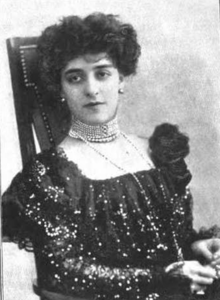

Wanda de Boncza (8 March 1872 – 15 August 1902) was a French actress, born Wanda-Marie-Émilie Rutkowska.
Early life
Wanda-Marie-Émilie Rutkowska was born in Paris, the daughter of Polish-Jewish immigrants. [1] She studied comedy at the Conservatoire de Paris with Gustave Worms. [2] [3]
Career
Wanda de Boncza was considered a stage beauty in Paris, [4] acting first at the Odéon, and then at the Comédie-Française. One English-language critic in 1901 described her stage presence as "little and dark, Parisian and perverse, she whose eyes are enigmas ... beautiful in her own odd way." [5] Her stage appearances included roles in Fiancée (1894), [6] La Barynia (1894), [1] On ne badine pas avec l'amour (1896), [7] Struensée (1898), La Conscience de l'enfant (1899), Alkestis (1900), and Le Marquis de Priola (1902). [8]
Personal life
Wanda de Boncza died in Paris in 1902, aged 30 years, [9] from appendicitis [10] [11] and an attempted surgical intervention. [1] [8] Some reports also mentioned that morphine addiction may have contributed to her early death. [12] A few months after her death, [13] there was an auction of her jewelry (especially pearls), gowns, and other possessions, yielding over a million francs, more than enough to pay off her gambling and other debts. [2] [14] [15] [16]
References
- ^ a b c H. C. "Nécrologie" Revue universelle (Paris 1902): 429.
- ^ a b Sterling Heilig, "The Jewel-Spangled Beauties of Paris" New York Press (January 11, 1903): 3.
- ^ Cecil Nicholson, "The Stage" The Academy and Literature (29 September 1894): 238.
- ^ "Paris's Most Beautiful Actress" New York Times (16 May 1896): 5. via ProQuest
- ^ Vance Thompson, "Beauty on the Paris Stage" Cosmopolitan (January 1901): 240-241.
- ^ L. K., "Paris has a New Play and Player" New York Times (4 November 1894): 4. via ProQuest
- ^ "Théatres" Revue bleue (5 December 1896): 730.
- ^ a b Untitled essay, Truth (21 August 1902): 448-449.
- ^ "Wanda de Boncza" Sketch (3 December 1902): 253.
- ^ "What Paris Talks About" New York Times (21 December 1902): 5. via ProQuest
-
^
"Death of Mdlle. Wanda de Boncza" The Observer (17 August 1902): 7. via
Newspapers.com

-
^
"Victims of Morphia" Evening Star (13 June 1903): 22. via
Newspapers.com

- ^ André Fagel, "La Vente de Wanda de Boncza" L'Illustration" (6 December 1902): 442.
- ^ George Frederick Kunz and Charles Hugh Stevenson, The Book of the Pearl: Its History, Art, Science, and Industry (Courier Corporation 2013): 479. ISBN 9780486142746
- ^ "Wanda de Boncza" Musica E Musicisti (1903): 62.
-
^
"Owes Paris Costumers $100,000 for Gowns" Chicago Tribune (1 September 1902): 5. via
Newspapers.com

External links
- A cigarette card featuring Wanda de Boncza, from the New York Public Library Digital Collections.
- A photograph of Wanda de Boncza in the collection of the Musée d'Orsay, Paris.


Wanda de Boncza (8 March 1872 – 15 August 1902) was a French actress, born Wanda-Marie-Émilie Rutkowska.
Early life
Wanda-Marie-Émilie Rutkowska was born in Paris, the daughter of Polish-Jewish immigrants. [1] She studied comedy at the Conservatoire de Paris with Gustave Worms. [2] [3]
Career
Wanda de Boncza was considered a stage beauty in Paris, [4] acting first at the Odéon, and then at the Comédie-Française. One English-language critic in 1901 described her stage presence as "little and dark, Parisian and perverse, she whose eyes are enigmas ... beautiful in her own odd way." [5] Her stage appearances included roles in Fiancée (1894), [6] La Barynia (1894), [1] On ne badine pas avec l'amour (1896), [7] Struensée (1898), La Conscience de l'enfant (1899), Alkestis (1900), and Le Marquis de Priola (1902). [8]
Personal life
Wanda de Boncza died in Paris in 1902, aged 30 years, [9] from appendicitis [10] [11] and an attempted surgical intervention. [1] [8] Some reports also mentioned that morphine addiction may have contributed to her early death. [12] A few months after her death, [13] there was an auction of her jewelry (especially pearls), gowns, and other possessions, yielding over a million francs, more than enough to pay off her gambling and other debts. [2] [14] [15] [16]
References
- ^ a b c H. C. "Nécrologie" Revue universelle (Paris 1902): 429.
- ^ a b Sterling Heilig, "The Jewel-Spangled Beauties of Paris" New York Press (January 11, 1903): 3.
- ^ Cecil Nicholson, "The Stage" The Academy and Literature (29 September 1894): 238.
- ^ "Paris's Most Beautiful Actress" New York Times (16 May 1896): 5. via ProQuest
- ^ Vance Thompson, "Beauty on the Paris Stage" Cosmopolitan (January 1901): 240-241.
- ^ L. K., "Paris has a New Play and Player" New York Times (4 November 1894): 4. via ProQuest
- ^ "Théatres" Revue bleue (5 December 1896): 730.
- ^ a b Untitled essay, Truth (21 August 1902): 448-449.
- ^ "Wanda de Boncza" Sketch (3 December 1902): 253.
- ^ "What Paris Talks About" New York Times (21 December 1902): 5. via ProQuest
-
^
"Death of Mdlle. Wanda de Boncza" The Observer (17 August 1902): 7. via
Newspapers.com

-
^
"Victims of Morphia" Evening Star (13 June 1903): 22. via
Newspapers.com

- ^ André Fagel, "La Vente de Wanda de Boncza" L'Illustration" (6 December 1902): 442.
- ^ George Frederick Kunz and Charles Hugh Stevenson, The Book of the Pearl: Its History, Art, Science, and Industry (Courier Corporation 2013): 479. ISBN 9780486142746
- ^ "Wanda de Boncza" Musica E Musicisti (1903): 62.
-
^
"Owes Paris Costumers $100,000 for Gowns" Chicago Tribune (1 September 1902): 5. via
Newspapers.com

External links
- A cigarette card featuring Wanda de Boncza, from the New York Public Library Digital Collections.
- A photograph of Wanda de Boncza in the collection of the Musée d'Orsay, Paris.